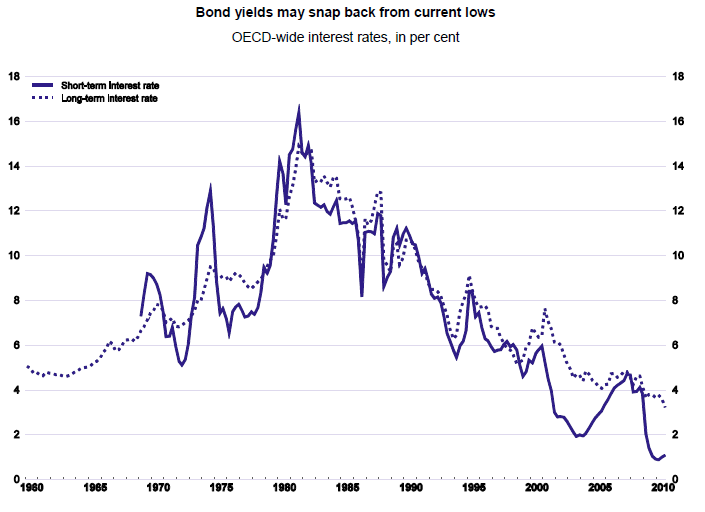

12/15/2010
by Hans Wagner
Bonds have been on a roll delivering double-digit returns for many investors as interest rates kept falling. With the Federal Reserve's quantitative easing II program and another government stimulus program in the works, bond investors might finally believe that fall in interest rates is nearing an end.
Bonds are often considered a safe investment. After all many investment advisors suggest that as you approach retirement you should allocate more of your portfolio to bonds. For the last 30 years this worked well as long term Treasury rates fell from a high of almost 14 percent to just over 4 percent recently. When interest rates fall, bond prices rise.
There are two components to bond returns. One is the yield and the other is the appreciation or depreciation of the principal when the yield changes.
Yield is what an investor receives in interest payments based on the terms of the bond when purchased. Once purchased the interest received remains the same. If you hold the bond to maturity, you will receive the promised payments and the return of the principal.
However, the principal can vary as the market rates change over time. When rates decline as the have over the last thirty years, the return you receive from a bond or a bond fund is enhanced as the value of the principal increases. Investors have enjoyed a nice yield from their bonds while receiving an additional kick from the appreciation in the value of the bonds.
As shown in the chart below the yield on the 30-year Treasury bond has declined for 30 years. This drop in yields was responsible for the 30-year rally in bonds that is coming to an end.

With rates at historical lows, investors cannot count on much more gain from their principal as rates are more likely to rise than fall in the future. If rates do rise, the value of the principle falls offsetting some or all of your yield.
Once interest rates begin to climb, bond investors will no longer be able to count on the appreciation in their principle to contribute to their returns. Should rates rise rapidly, bond investors could experience actual losses as the drop in the principle value exceeds the return from the yield.
Of course, as rates rise the yield you can receive from new purchases of bonds will be higher helping to offset the loss of principle.
As bond investors realize they no longer are able to receive gains similar to the last 30 years, we should expect some money to move from the bond market to other investments, including stocks. These investors are looking for higher returns than they can obtain from the bond market. The stock market offers investors the potential to receive higher gains. The movement of money from bonds to stocks generates new bids encouraging prices to rise.
Monitoring the money flows into and out of bonds and bond funds is a useful analysis. The Investment Company Institute provides a weekly report on the money flow trends for stock, hybrid, taxable bond, municipal bond, taxable money market, and tax-free money market funds. Trim Tabs also offers a similar service.
Recently, in the last week of November, the first out flow from bonds took place since the middle of December 2008. While the bond market saw new inflows the two weeks later, this event is a warning that the thirty-year rally in the bond market might be over.
As experienced investors know, they do not announce the rally is over. Yet there is a rational argument that the rally in the bond market is nearing an end and stock investors will benefit.
Our Stock and Sector Portfolios for our Premium Members recognize the affect of deleveraging that continue to help us bear the market every year. If you are interested, we offer a no risk, free four-week trial. You have nothing to lose and money to make.